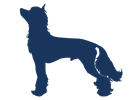Varieties of Chinese Crested Dogs
The following information was written by DeLisa Parker based on her research and years of experience breeding, training and loving Chinese Crested dogs. If you have any questions about the information on this page or the breed please feel free to contact us at inquiry@belewschinesecresteds.com.
The Chinese Crested comes in two distinct varieties, the Hairless and the Powderpuff. The Powderpuff is covered in a double, soft and silky coat that should be straight and of medium length and density. The Hairless has hair on its head or "crest", its feet or "socks" and its tail or "plume". This is commonly referred to as the dog's "furnishings".
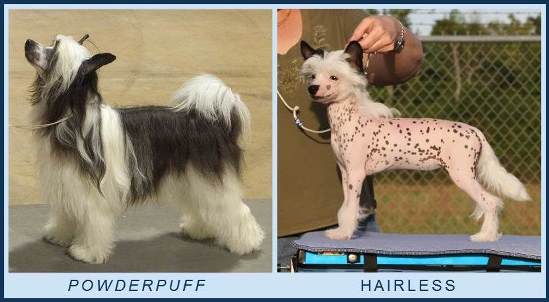 The Chinese Crested is not a true hairless breed and for this reason, the amount and placement of body hair can vary from one dog to the next. Terms used to categorize the Hairless Chinese Crested are "Hairy Hairless" for a dog that has a moderate amount of body hair and "True Hairless" for a dog with very little body hair.
The Chinese Crested is not a true hairless breed and for this reason, the amount and placement of body hair can vary from one dog to the next. Terms used to categorize the Hairless Chinese Crested are "Hairy Hairless" for a dog that has a moderate amount of body hair and "True Hairless" for a dog with very little body hair.
Most show dogs are groomed to remove excess body hair.
Even a true Hairless may have stray hairs in places that should be removed for the show ring. Generally, show dogs with long, flowing furnishings will have more body hair than ones with thin, sparse furnishings.
A very hairy hairless should not be mistaken for a coated dog when its hair is allowed to grow naturally. Typically, excess body hair will grow down the back and up the legs with sparse to no hair growing on the dog’s sides, chest and undercarriage. If the Crested’s hair is allowed to grow naturally and the dog looks like a coated dog, it is probably a Powderpuff.
Chinese Crested Teeth
According to the AKC Breed standard, the only difference between the Powderpuff and the Hairless (besides the coat) is the teeth. A Powderpuff should have full dentition, missing teeth are faulted in the show ring. In the Hairless, missing teeth are common and acceptable. This is because the gene that causes the hairlessness may be linked to the gene that causes missing teeth.
The Hairless Crested’s teeth may have a slightly different shape than a normal dog’s teeth but this difference is not always apparent to someone unfamiliar with the breed. The Crested puppy’s canines should not be pulled unless the adult canine is clearly visible or a vet has x-rayed the dog to verify that it does in fact have adult teeth.
Chinese Crested Ears
The AKC Breed standard calls for large erect ears in both the Hairless and Powderpuff variety. However, the Canadian Kennel Club allows drop ears on the Powderpuff.
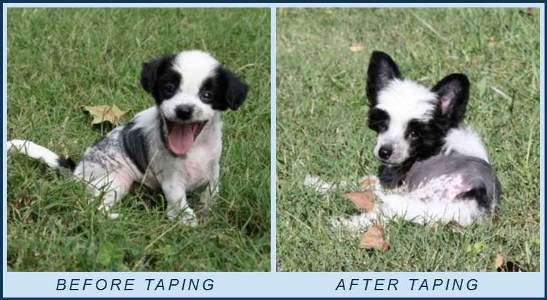
If a puppy's ears do not stand on their own, it is common practice to tape the ears to help strengthen the muscle and encourage the ears to stand. The ears can be taped when the puppy is between 6 to 8 weeks old and kept taped until the ears stand on their own. This may take a week or several months.
If done properly, the result is a Chinese Crested whose ears will always stand erect. However, a Crested’s ears may never stand. This is perfectly acceptable for pet puppies or Powderpuffs being shown in Canada or other countries where drop ears are permissible.
There are many different methods and products for taping ears. A new owner should not tape a puppy's ears without proper instructions and guidance. If taped incorrectly, the ears may never stand correctly. In addition, taping the ears can lead to ear and skin infections. If the tape is not removed properly with adhesive remover, it can be painful for the puppy and the skin can be damaged.
Chinese Crested Coat and Skin Colors
Both Hairless and Powderpuff Chinese Cresteds come in many different colors including white, black, slate, cream, apricot, orange, red, palomino, chocolate, silver, gray and any combination of colors. Many Cresteds will change colors their entire life.
Grooming the Powderpuff Chinese Crested
The Powderpuff Chinese Crested has a double coat. It should be soft, silky, straight and a moderate length and density. The AKC Breed standard states that grooming is minimal. While this may be true in comparison to a Yorkie Terrier or Maltese, a Powderpuff still requires a bit of work. The dog should be brushed several times a week to prevent matting and bathed about once a week, depending on how much time the dog spends outdoors.
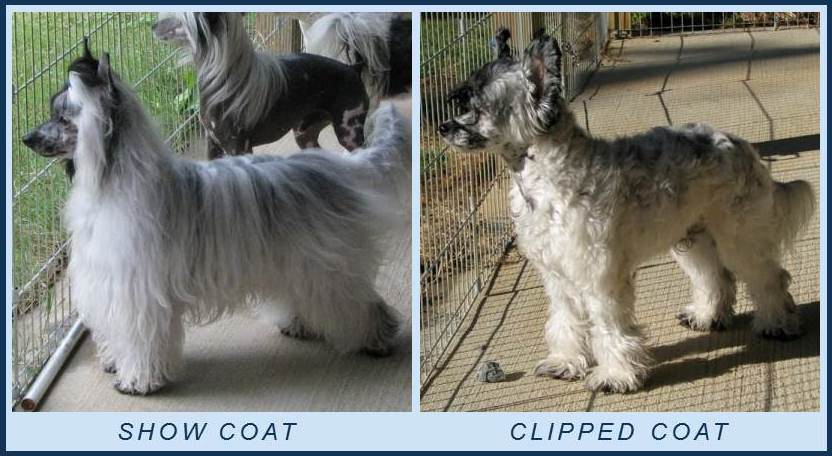
Many Crested owners prefer to keep their Powderpuff’s coat clipped short. It is much easier to keep the dog clean and the coat is less likely to mat. The dog would need to be clipped every three or four months. This should be done by someone with the proper equipment and training.
Grooming the Hairless Chinese Crested
Taking care of the Hairless Chinese Crested’s skin and coat can be a simple task or a complicated one. There are many variables and the amount of work involved depends on the individual dog and owner. The Hairless Chinese Crested can be bathed with the same products used on any other dogs or even human products. If a rash develops or they start scratching shortly after bathing, they may be allergic to something in one of the products you used. Lanolin is a common culprit.
Hairless Chinese Crested’s may get blackheads and acne. Like human skin, many factors can cause breakouts. Here are a few things that may contribute:
- Changing hormones can cause the skin to breakout. Many Hairless Chinese Cresteds go through a "teenage" acne period when they are between 6 months and 2 years old. In addition, girls may breakout before, during or after their heat cycle.
- A dog that is not bathed enough or bathing the dog too often may cause acne.
- Products that dry the skin or clog the pores can cause breakouts. Some dogs are sensitive to certain ingredients in products. A product that is not used according to the directions may cause skin irritation and/or breakouts. Be sure to read labels and follow the directions.
- Dirty clothes and/or bedding can cause breakouts. Wearing clothes for prolonged periods may not be good for the skin. If the dog wears clothes all the time, his clothes should be changed, every day and anytime the clothes become dirty or wet. The dog may be allergic to the material and/or the detergents used. Wool is itchy and can cause irritation and/or allergic reactions.
- Clipping and/or shaving can cause razor burn and/or breakouts.
- A poor diet and/or eating certain foods can cause breakouts.
- Some dogs, like humans are more prone to acne.
Most products that are used to treat and prevent acne in humans can also be used on the Hairless Chinese Crested. Prevention is the key. A weekly bath with a quality shampoo and conditioner, clean clothes and bedding, fresh water, a good diet, fresh air and exercise are essential. The trick is to find what works best for each individual dog. If something worked well for one dog, do not assume it will work for every dog. Resist the urge to squeeze pimples or blackheads. This can cause infections, scarring and discolor the skin. If the dog has severe breakouts, consult a vet.
The Hairless Chinese Crested's skin may become sunburned, especially lighter colored dogs. It is good for them to spend time outside on a sunny day but you may need to limit their exposure to the sun by providing shady areas, protective clothing and/or sunscreen.
Sunscreen for sensitive skin, babies and/or young children usually works well.In addition, there are some quality lotions on the market with SPF. Keep in mind that sunscreen and lotion can clog the pores. It is a good practice to wipe the skin with a clean wet washcloth at the end of the day.
Some dogs are not as sensitive to the sun and others may build up a base tan towards the end of the summer so they do not burn as easily. In general, young puppies that have never been exposed to the sun will burn very quickly. If your dog is sunburned, use an after sun aloe lotion to help soothe the skin. If you are concerned about the severity of the sunburn, take the dog to a vet.
A Chinese Crested that is going to be shown should only have hair on the head, tail and feet. The rest of the body should feel soft and smooth. Most exhibitors remove some body hair before judging. This is accomplished by clipping and/or shaving.
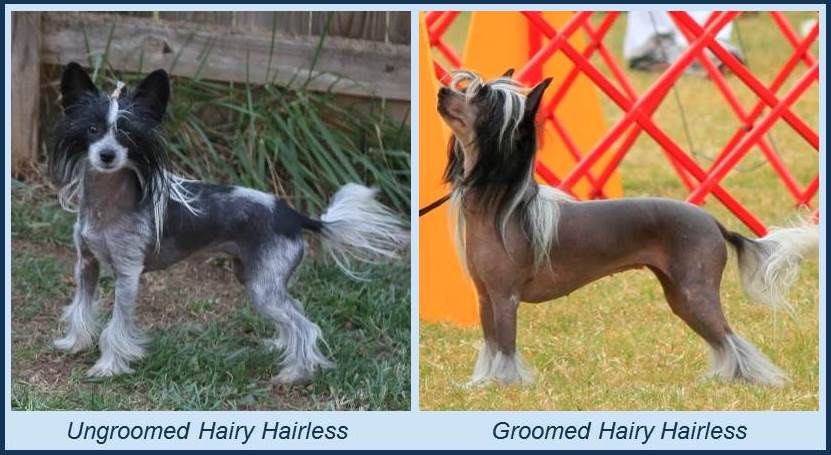
A new Chinese Crested exhibitor should be shown how to groom their Hairless Chinese Crested for the show ring. For a pet Chinese Crested, clipping excess body hair is optional.
Chinese Crested Temperament
The Chinese Crested is a gay and alert dog that enjoys human companionship. They are funny little dogs that like to please their owners. If they find something that amuses you, they are likely to do it again to get your attention. Chinese Cresteds are said to be "cat-like" and enjoy sitting in high places like the back of a couch or the arm of a chair.
Their activity level is medium to high but they enjoy quiet times with their family. They can adjust well to apartment living. They learn quickly and can do well in various performance sports such as agility, obedience, fly ball, lure coursing and many other dog sports. Chinese Cresteds do not respond well to negative reinforcement methods of training. They are sensitive and can have a hard time overcoming a bad experience.
The Chinese Crested needs early socialization. They should be exposed to many different environments, people and other pets when they are young. Without this early socialization, they may become fearful and will not cope well to changes.
In general, the Chinese Crested is not a "yappy" dog. Again, this depends on the individual dog and the owner. Any dog that is allowed to bark repeatedly for no good reason will continue to bark repeatedly for no good reason. Typically, Cresteds will bark when they hear or see something out of the ordinary, but they usually quiet down when things go back to normal or when they are told to quiet down.
Most Hairless Cresteds do not like rainy or cold weather. Put a jacket on them before taking them outside. Cresteds prefer to be with their pack. Go outside with your puppy when it is time to potty. Stay outside with him or her even if it is cold or rainy. Be cheerful, positive and patient. Cresteds are very in tuned to their owner’s mood. Walk around and encourage the puppy to follow you. Praise, praise and more praise when the puppy potties outside. Cresteds love to please their people. Eventually, they will develop habits that will stay with them throughout their lifetime.
Chinese Crested Health and Genetics
Chinese Cresteds are generally healthy dogs with an average life expectancy of 15 years or more. Some health concerns with Chinese Cresteds are:
- The Chinese Crested may develop allergies that cause rashes, breakouts and itchy skin. The first and most difficult step is to determine the source of the allergy. If possible, remove the allergen from the dog’s environment or ask your vet what can be done to alleviate some of the dog’s discomfort.
- The Hairless Chinese Crested may have missing teeth and/or lose teeth, as they grow older. Both the Puff and Hairless are prone to tartar buildup, which can lead to gum disease. This can be prevented by brushing the teeth and having the teeth cleaned regularly by a vet.
Tests are available to improve the health of future generations of Chinese Cresteds. Responsible breeders will have the following tests done before a dog is bred:
- Patellar Luxation is a misalignment of the knee joint that can cause the dog to limp or hop when running. It can be painful for the dog and may require surgery. This condition can be caused by an injury or may be inherited from the dog’s parents. Breeders should have the patella checked on any dog they plan to use in their breeding program. This is a onetime exam that should be performed by a vet anytime after the dog is a year old.
- Any Chinese Crested that is being used for breeding purposes should have their eyes examined every year by a board certified Veterinary Ophthalmologist. This is typically called a "CERF" exam because the results are submitted to the Canine Eye Registration Foundation (CERF) and the owner is given a CERF certificate showing the results.
- Heart disease is a genetic health problem that can shorten a dogs life expectancy. A cardiac examination should be performed by a veterinary using a stethoscope to listen for any irregularities in the heart. Most vets check the heart during a routine physical examination.
Genetic tests are available to help breeders eliminate certain hereditary disease from their breeding program. The test result will tell us if a dog is clear, carrier or affected. A clear dog does not have the gene that causes the disease. They will never be affected and never produce any affected offspring. A carrier is a dog that has the gene that causes the disease. He will not be affected by the disease but can produce offspring that are affected. An affected dog carries the gene and is very likely to be affected by the disease. A gene marker has been found for the following diseases in Chinese Cresteds:
- prcd-PRA is a hereditary disease that causes the retina of the eye to degenerate slowly over time causing declining vision and eventual blindness. There is no known cure. A test is available for the genetic marker that causes one form of prcd-PRA.
- PRA-rcd3 is an early onset of Progressive Retinal Atrophy that affects the photoreceptor cells in the eye causing loss of peripheral vision and night blindness in the early stages of the disease. Most dogs affected with PRA-rcd3 are totally blind by the time they are one year of age but some dogs retain limited vision until they are 2 or 3 years of age.
- Primary Lens Luxation is a hereditary disease that causes the lens of the eye to dislocate from its normal position. The dislocated lens will move forward through the pupil or backwards into the Vitreous Chamber of the eye. It is very painful for the dog and requires immediate veterinary attention. Most dogs with PLL will need to have their eye removed. A dog that has a luxation in one eye is more likely to have one in the other eye as well. Severe trauma to the eye can also cause the lens to luxate.
Testing for a disease’s genetic marker is a valuable tool for responsible breeders. There are three types of genetic markers: clear, carrier and affected. This gives us six possible combinations when breeding:
- Clear + Clear: All offspring will be clear. No carriers. No affected.
- Clear + Carrier: Offspring will be both clear and carriers. No affected.
- Clear + Affected: All offspring will be carriers. No clear. No affected.
- Carrier + Carrier: All offspring will be carriers. Some offspring may be affected.
- Carrier + Affected: All offspring will be carriers. Some offspring may be affected.
- Affected + Affected: All offspring will be carriers. All offspring will be affected.
It is important to note that carrier and affected dogs do not have to be removed from a breeding program. As long as the carrier or affected dog is bred to a clear dog, no offspring will be affected by the disease.
Many times, breeders will say a dog is "clear by default". This means that both its parents were clear and the dog does not need to be tested. It is clear because both of its parents are clear. In addition, breeding a clear to an affected would only produce carriers so testing those offspring would not be required. They would be "carrier by default".
Genetic diversity is important in any breed. These genetic tests allow breeders to maintain genetic diversity while striving to eliminate hereditary diseases from their breed.
|

